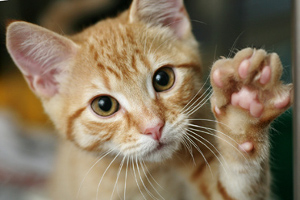 As with our own, the condition of our pets’ nails and skin is dependent on their health. If your dog or cat’s nails and skin are in a chronic shabby state, the best thing you can do is to feed a well-balanced and nutritious raw meat diet. Supplements can also help. Horsetail is used to improve nail health. Myrrh, used topically, can help strengthen nails that often split and crack. Fungal infections can be treated with tea tree oil or grapefruit seed extract. See the precaution about tea tree oil in our Essential Oils section. Also, if your pet has a fungal infection, try adding grapefruit seed extract, noni, olive leaf extract, or acidophilus to food.
As with our own, the condition of our pets’ nails and skin is dependent on their health. If your dog or cat’s nails and skin are in a chronic shabby state, the best thing you can do is to feed a well-balanced and nutritious raw meat diet. Supplements can also help. Horsetail is used to improve nail health. Myrrh, used topically, can help strengthen nails that often split and crack. Fungal infections can be treated with tea tree oil or grapefruit seed extract. See the precaution about tea tree oil in our Essential Oils section. Also, if your pet has a fungal infection, try adding grapefruit seed extract, noni, olive leaf extract, or acidophilus to food.
Cats
Interdigital Dermatitis
 As the name implies, interdigital dermatitis is inflammation and irritation of the skin between the toes. It’s usually caused by an allergic reaction to something the cat has stepped on, which then causes aggressive licking. Cats can be allergic to many grasses and plants, and even to carpet fibers.Other allergens, including ingredients in the diet, can also cause this reaction. The licking and the allergic reaction combined cause bacteria to multiply.
As the name implies, interdigital dermatitis is inflammation and irritation of the skin between the toes. It’s usually caused by an allergic reaction to something the cat has stepped on, which then causes aggressive licking. Cats can be allergic to many grasses and plants, and even to carpet fibers.Other allergens, including ingredients in the diet, can also cause this reaction. The licking and the allergic reaction combined cause bacteria to multiply.
The treatment of interdigital dermatitis depends on the underlying cause, and you need to try to find out what the allergen is. See the page on allergies for more information. In many cases, secondary bacterial infections are present. 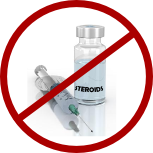 Chlorhexidine is a good antiseptic to use on the area first, and then tea tree oil or grapefruit seed extract. Twice a day applications ought to clear things up unless there is an ongoing allergy. Likewise, salves made with these ingredients and calendula oil have been known to help. It’s also possible that a parasite is the problem. See Parasites.
Chlorhexidine is a good antiseptic to use on the area first, and then tea tree oil or grapefruit seed extract. Twice a day applications ought to clear things up unless there is an ongoing allergy. Likewise, salves made with these ingredients and calendula oil have been known to help. It’s also possible that a parasite is the problem. See Parasites.
If the condition persists, see a holistic veterinarian. Try to get to the root of the problem. If you see a conventional veterinarian, he or she may prescribe recurring steroid and/or antibiotic treatments, sometimes for life, which you want to avoid. Overuse of these drugs has been proven to cause serious systemic illnesses.
Nails
Cats’ nails have a hard outer covering with blood vessels and nerves inside. To see your cat’s nail, gently squeeze the paw pad to make the nail pop out. You should see an inner pinkish area a few millimeters from the end of the nail. This is the blood vessel, otherwise known as “the quick.”
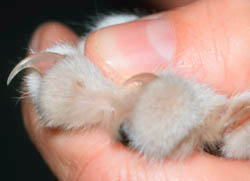 Some people recommend clipping a cat’s nails once a week. Not all cats need this kind of maintenance, though. Some cats naturally file their nails with regular scratching on abrasive surfaces. You should, however, inspect your cat’s nails during your routine home health check, which would optimally be done weekly. Make sure to check the dew claws. (See the information on dew claws in the dog section, below). Besides keeping your cat’s nails at an appropriate length, clipping the tips off can help with scratching problems because the hook at the end does the most damage.
Some people recommend clipping a cat’s nails once a week. Not all cats need this kind of maintenance, though. Some cats naturally file their nails with regular scratching on abrasive surfaces. You should, however, inspect your cat’s nails during your routine home health check, which would optimally be done weekly. Make sure to check the dew claws. (See the information on dew claws in the dog section, below). Besides keeping your cat’s nails at an appropriate length, clipping the tips off can help with scratching problems because the hook at the end does the most damage.
The best way to clip the nails is by calmly and snugly wrapping your cat in a towel and then exposing one leg at a time. Use quality nail clippers, preferably the guillotine kind, and pop the nail out by gently squeezing the base of the nail and the paw pad between your thumb and index finger. 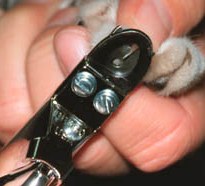 Clip in the direction shown in the picture, not crosswise, or else you will crush and shatter the nail. Do not clip so short that you snip the inner blood vessel. Not only will your cat bleed, but it will hurt and frighten the cat, and you will have a very difficult time trimming nails in the future if the cat associates the trimming procedure with this sort of pain. You should keep some styptic powder nearby, such as Kwik Stop, in case you do, unfortunately, cut into the quick.
Clip in the direction shown in the picture, not crosswise, or else you will crush and shatter the nail. Do not clip so short that you snip the inner blood vessel. Not only will your cat bleed, but it will hurt and frighten the cat, and you will have a very difficult time trimming nails in the future if the cat associates the trimming procedure with this sort of pain. You should keep some styptic powder nearby, such as Kwik Stop, in case you do, unfortunately, cut into the quick.
If your cat is scratching furniture, take measures to correct the unwanted behavior. Punishing the cat may seem logical, but it is not an effective solution. The cat will probably still scratch the furniture when you aren’t looking. Scratching is a natural behavior for cats; it not only feels good, it’s their instinctive way of identifying turf using scent glands in their paws and physical markings. You need to offer more appealing scratching equipment, appealing to your cat, not to you.
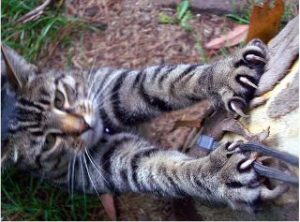 The scratching post with the most appeal to your cat is often a tree stump, but this is hard to replicate in the house. Whatever post you choose, it must be tall enough for the cat to fully extend its body. It also must be secure. If the post falls over even once, your cat probably won’t give it another try. For lightweight posts, it’s often a good idea to brace the post in a corner wall or turn it on its side.
The scratching post with the most appeal to your cat is often a tree stump, but this is hard to replicate in the house. Whatever post you choose, it must be tall enough for the cat to fully extend its body. It also must be secure. If the post falls over even once, your cat probably won’t give it another try. For lightweight posts, it’s often a good idea to brace the post in a corner wall or turn it on its side.
In Dr. Pitcairn’s Complete Guide to Natural Health for Dogs and Cats, Richard Pitcairn recommends sisal as the material cats like to scratch most. He says you can make your own 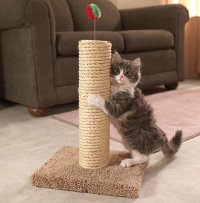 post by nailing a 4 x 4 to a flat piece of wood about ½” thick and sixteen inches square, and then wrapping the post with sisal rope. An alternative to sisal is the underside of carpet, the rough side. The soft side of the carpet may look good to you, but it’s often not appealing enough to the cat.
post by nailing a 4 x 4 to a flat piece of wood about ½” thick and sixteen inches square, and then wrapping the post with sisal rope. An alternative to sisal is the underside of carpet, the rough side. The soft side of the carpet may look good to you, but it’s often not appealing enough to the cat.
Dr. Pitcairn says you can coax a cat to scratch the post by placing the cat on top of the sideways lain post and then firmly stroking the cat’s neck and back while making scratching motions on the sisal with your other hand. He says the stroking stimulates the cat’s response to scratch. He advises against taking the cat’s paws and scratching the post with them because this will only cause resistance.
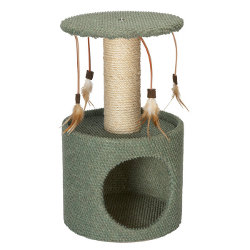 The post should be in an area that’s used often by the cat, an area where family gathers, not hidden in a back corner. If your cat has already been scratching something, the couch, for instance, put the post there. Gradually, you can move the post to a more desirable location, if you prefer.
The post should be in an area that’s used often by the cat, an area where family gathers, not hidden in a back corner. If your cat has already been scratching something, the couch, for instance, put the post there. Gradually, you can move the post to a more desirable location, if you prefer.
Encourage your cat with treats and play by the post. Rub a little catnip into it. Make all associations with the post pleasurable. Reward your cat with a favorite delicacy when she uses it. Play with a string or feathers around the post, or attach toys to it. This should cause the cat to claw into the material, which will trigger instinctive use. 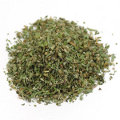 You may also want to put a post where the cat sleeps. Cats like to scratch when they wake up, especially in the morning and the middle of the night. Putting scratching posts in multiple rooms of the house is ideal.
You may also want to put a post where the cat sleeps. Cats like to scratch when they wake up, especially in the morning and the middle of the night. Putting scratching posts in multiple rooms of the house is ideal.
When playing, never allow your cat to bite or scratch your skin. Allowing this behavior in play teaches your cat that it’s okay to bite and scratch people. Use a string or some other toy instead of your hands in prey-catching games. In The New Natural Cat, Anita Frazier describes what to do if your cat is a people-scratcher. She advises that you always stay calm, and when the claws are in you, gently push the 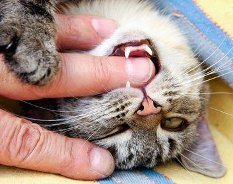 cat’s paw forward slightly to unlatch the tips of the nails. If the cat is biting, push the bitten body part toward the teeth, which will confuse the cat into letting go. Once disengaged, gently move the cat away from you with a composed message of disapproval and then ignore the cat for several minutes.
cat’s paw forward slightly to unlatch the tips of the nails. If the cat is biting, push the bitten body part toward the teeth, which will confuse the cat into letting go. Once disengaged, gently move the cat away from you with a composed message of disapproval and then ignore the cat for several minutes.
While you’re working at getting the cat interested in the new scratching post, there are things you can do to discourage scratching the furniture. Cover areas that the cat likes to scratch with surfaces that are not appealing, such as double-sided tape or tin foil. If your cat likes to claw drapes, roll them up and out of the way until the habit is broken. Removing scent marks from habitual scratching objects is also a good idea. You can use odor removing substances and citrus scented sprays for further deterrence.
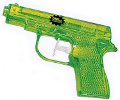 If your cat still persists in scratching the furniture, try using a water gun or a spray bottle set on stream. Another option is a loud whistle or other noise-maker. You must employ these deterrents while the cat is scratching for them to be effective.
If your cat still persists in scratching the furniture, try using a water gun or a spray bottle set on stream. Another option is a loud whistle or other noise-maker. You must employ these deterrents while the cat is scratching for them to be effective.
Do not declaw your cat. Declawing is maiming, a mistake that can lead to physical, emotional and behavioral problems. It is erroneous to think that declawing a cat is a trivial procedure similar to trimming fingernails. A cat’s claws are a vital part of its anatomy, essential to balance, mobility and survival.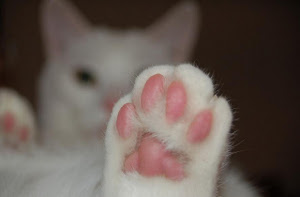
Declawing is equivalent to cutting off the first joint of all your fingers and toes. It is a very painful and difficult procedure with a high risk of secondary complications that many conscientious veterinarians refuse to do. Declawing is against the law in some countries because it has been ruled inhumane. Physically, it can damage the tendons, impair balance, and cause muscular atrophy from disuse. Mentally, declawing can cause the cat to feel defenseless and nervous, leading to stress and behavioral issues. The stress can weaken your cat’s immune system. Some cats develop an aversion to their litter box because of the pain associated with scratching in the litter. This may drive the cat to find a more comfortable place to defecate. The cat is also more likely to become a biter. Often, these habits are hard to break. Also, of course, your cat is left vulnerable and defenseless.
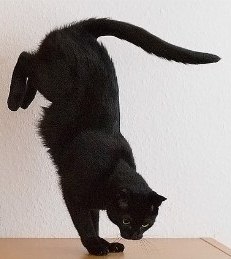 Declawed cats tend to shift their weight unnaturally to their back legs. Being out of balance like this is extremely distressing to a cat. Cats are known for their acrobatic abilities such as tree climbing, walking along narrow branches, leaping incredible heights to land in precise locations, and navigating through complex obstacle courses of knickknacks without disturbance. These are acts of balance and part of a cat’s basic heritage. Declawing is physically and emotionally damaging to your cat.
Declawed cats tend to shift their weight unnaturally to their back legs. Being out of balance like this is extremely distressing to a cat. Cats are known for their acrobatic abilities such as tree climbing, walking along narrow branches, leaping incredible heights to land in precise locations, and navigating through complex obstacle courses of knickknacks without disturbance. These are acts of balance and part of a cat’s basic heritage. Declawing is physically and emotionally damaging to your cat.
Paronychia
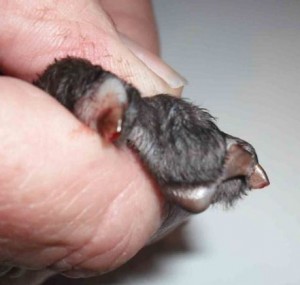 Paronychia is a condition where the ends of the toes are infected, tender and inflamed, and the paws appear malformed. The cat has difficulty extending the claws because of swelling, and sticky pus is visible in the claw fold. Extend the claws and clean the area using cotton and hydrogen peroxide. Then apply tea tree oil or grapefruit seed extract. Adding olive leaf extract to your pet’s food may help, too. If the infection does not show signs of clearing up after a couple of days, see a veterinarian.
Paronychia is a condition where the ends of the toes are infected, tender and inflamed, and the paws appear malformed. The cat has difficulty extending the claws because of swelling, and sticky pus is visible in the claw fold. Extend the claws and clean the area using cotton and hydrogen peroxide. Then apply tea tree oil or grapefruit seed extract. Adding olive leaf extract to your pet’s food may help, too. If the infection does not show signs of clearing up after a couple of days, see a veterinarian.
Pustules – See Abscesses and Pustules
Dogs
Interdigital Dermatitis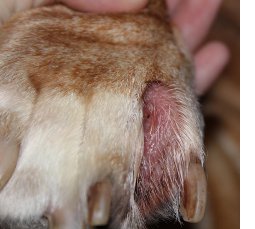
As the name implies, interdigital dermatitis is inflammation and irritation of the skin between the toes. It’s usually caused by an allergic reaction to something the cat has stepped on, which then causes aggressive licking. Dogs can be allergic to grasses and plants, and even carpet fibers. Other allergens, including ingredients in the diet, can also cause this reaction. The licking and the allergic reaction combined cause bacteria to multiply.
The treatment of interdigital dermatitis depends on the underlying cause, and you need to try to find out what the allergen is. See Allergies for more information. In many cases, secondary bacterial infections are present.  Chlorhexidine is a good antiseptic to use on the area first, and then tea tree oil or grapefruit seed extract. Twice a day applications ought to clear things up unless there is an ongoing allergy. Likewise, salves made with these ingredients and calendula oil have been known to help. It’s also possible that a parasite is the problem. See Parasites.
Chlorhexidine is a good antiseptic to use on the area first, and then tea tree oil or grapefruit seed extract. Twice a day applications ought to clear things up unless there is an ongoing allergy. Likewise, salves made with these ingredients and calendula oil have been known to help. It’s also possible that a parasite is the problem. See Parasites.
If your dog won’t stop licking the area, you may need an Elizabethan collar or head bucket. If the condition persists, see a holistic veterinarian.  Try to get to the root of the problem. If you see a conventional veterinarian, he or she may prescribe recurring steroid and/or antibiotic treatments, sometimes for life, which you want to avoid. Overuse of these drugs has been proven to cause serious systemic illnesses.
Try to get to the root of the problem. If you see a conventional veterinarian, he or she may prescribe recurring steroid and/or antibiotic treatments, sometimes for life, which you want to avoid. Overuse of these drugs has been proven to cause serious systemic illnesses.
Nails
If your dog gets plenty of exercise walking on sidewalks and gravelly or rocky surfaces, you probably won’t need to trim the regular nails. You do, however, still have to keep an eye on the dew claws, which are the nails that grow higher up on the leg. 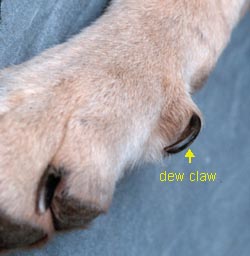 Dogs almost always have dew claws on the inside of their front legs. These are sometimes called the dog’s thumbs. Occasionally, dogs have dew claws on the back legs, too, and sometimes have more than one dew claw per leg. Because these nails don’t touch the ground and get naturally filed down, they need to be clipped regularly to avoid curling in on themselves or the skin.
Dogs almost always have dew claws on the inside of their front legs. These are sometimes called the dog’s thumbs. Occasionally, dogs have dew claws on the back legs, too, and sometimes have more than one dew claw per leg. Because these nails don’t touch the ground and get naturally filed down, they need to be clipped regularly to avoid curling in on themselves or the skin.
Nails need cutting if they touch the ground when the dog is standing upright, as the pressure can cause a painful condition in the joints of the toes. Maintaining proper nail growth on a regular schedule is also important because the vein inside the nail grows along with the nail. If your dog’s nails grow too long, you will have a harder time trying to trim back the nails without cutting into this inner vein, which is also called “the quick.”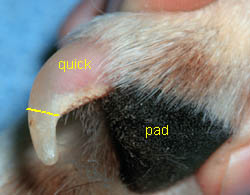
If your dog’s nails have grown to be too long, you’ll have to be patient with trimming them back gradually, allowing the quick to recede along with the nail. This inner vein is usually about seven millimeters or so from the tip of the nail, but this varies depending on the size and shape of the nail. If you cut into the quick, not only will you cause bleeding and pain, but you will have a harder time cutting the nails in the future because your dog will be scared. Have some styptic powder, such as Kwik Stop, handy in case you do, unfortunately, cut into the quick.
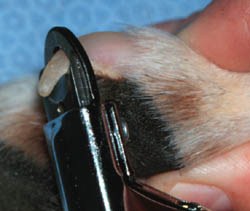 To trim the nails, you can use a nail file or Dremel grinder, but the best tool is probably a good quality guillotine style set of nail clippers. The flat surface of the guillotine blade should be parallel with the bottom of the pad. If the quick is visible, cut the nail to within about two millimeters from the end of the pink. Cut in the direction shown in the picture. If you cut the nail sideways, you will probably crush or splinter it.
To trim the nails, you can use a nail file or Dremel grinder, but the best tool is probably a good quality guillotine style set of nail clippers. The flat surface of the guillotine blade should be parallel with the bottom of the pad. If the quick is visible, cut the nail to within about two millimeters from the end of the pink. Cut in the direction shown in the picture. If you cut the nail sideways, you will probably crush or splinter it.
With dogs it can be difficult to see the inner vein if the nails are black. In this case, it’s often best to cut the nails back in several small clippings, each time looking at the cross section where the nail was clipped. 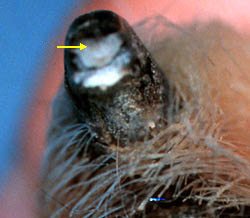 When you get close to the quick, you will be able to see it as a grayish-pink oval near the top of the nail, as shown in the picture. Stop clipping at that point.
When you get close to the quick, you will be able to see it as a grayish-pink oval near the top of the nail, as shown in the picture. Stop clipping at that point.
Paw Pad Problems
Dogs’ feet are the first line of defense against abrasive terrain and caustic substances on the ground. The paw pads can get cracked, burned, torn, or blistered, particularly if you like to exercise your dog with a bicycle or in extreme conditions. The exercise is very good for your dog, so instead of discontinuing the activity , you ought to try one of the products made to help toughen and/or protect paw pads, like Musher’s Secret. If your dog does get a cut or blister on the foot, the good news is that, if healthy, healing generally occurs quickly.
, you ought to try one of the products made to help toughen and/or protect paw pads, like Musher’s Secret. If your dog does get a cut or blister on the foot, the good news is that, if healthy, healing generally occurs quickly.
Deeper cuts in the pads or webbing between the toes may bleed a great deal because this area is very vascular. Quickly disinfect the area with povidone-iodine or whatever antiseptic you have around, and then wrap the foot in a tight bandage to stop the bleeding. If an object has pierced right through the pad or skin, you may need a veterinarian to suture the cut. There are sensitive tissues under the paw pad and if these become lacerated the dog will have pain and irritation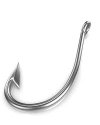 when walking on certain surfaces.
when walking on certain surfaces.
If your dog happens to get a fish hook caught in the foot, don’t try to pull the hook out against the barb. The shank of the hook should be cut, and then the hook pulled through the other way, so that the barb doesn’t pull the tissues. Unless you have the tools and experience to do this, you will probably need help from a veterinarian.